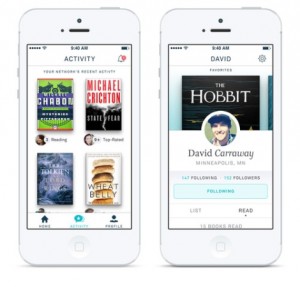 I’m obviously missing something about subscription eBook services and publishers. To me, it seems like they are a natural. Readers can try a book without worrying about the cost, probably leading them to try something they wouldn’t otherwise read. That’s great for book discovery, which is currently a big concern in the industry. When readers try a book, the publisher gets paid. Seems like a good match to me.
I’m obviously missing something about subscription eBook services and publishers. To me, it seems like they are a natural. Readers can try a book without worrying about the cost, probably leading them to try something they wouldn’t otherwise read. That’s great for book discovery, which is currently a big concern in the industry. When readers try a book, the publisher gets paid. Seems like a good match to me.
However, clearly I’m not seeing something. I read an article yesterday from Businessweek, where they were talking about the Digital Book World conference, and there was this quote:
Carolyn Reidy, the chief executive officer of Simon & Schuster (CBS), said at a panel on Tuesday that the company has been discussing subscriptions, but there were unresolved questions about how to avoid devaluing books and cannibalizing sales. For now, it’s staying away.
If a publisher is paid when the book is read, how is that devaluing books and cannibalizing sales? Why does the publisher care if they are paid when I buy a book or when I read it from a subscription service? According to an article from Digital Book World
Shatz and Batten both reminded the audience of their programs’ payment models for publishers. “As soon as someone reads a book in Oyster, we pay the publisher.” With Entitle, too, Batten said, “publishers get paid the way they would in a typical retail model.”
When publishers said they are concerned about the long term health of the services, that I understand. I have similar concerns, especially considering how I personally use Scribd. It’s the cannibalizing sales argument that I don’t get.
Anyone want to enlighten me?


































It’s no big mystery. Publishers are trying to stay profitable in an industry that has a very small profit margin.
The biggest and safest form of profitability is the one buyer/one book model.
If the model moves to the subscription model, they will be signing up for the very real possibility of the financial whims of these services in the same way as they have been tied to Amazon and its ilk.
Once consumers get accustomed to paying much less for books through subscription, they will no longer buy books. The subscription services will have the publishers by the small hairs, and the financial terms will go down.
Logically, the subscription services will have to pay less for the books because, as the terms are now, they are bleeding money.
For once, the publishers are being smart.
I’d like to know how much a publisher gets paid when I read via subscription. Full retail? Something less? Looking for analogs, does Netflix pay full price every time I view a DVD via my subscription? That doesn’t seem profitable given the cost vs the number of DVDs I can watch in a month.
So, just guessing, might publishers worry about this being a slippery slope that leads to Netflix-like returns?
Frank, tries these links for more information. The Friedman piece also has links to more info.
http://accrispin.blogspot.com/2014/01/scribds-new-ebook-subscription-service.html
http://janefriedman.com/2013/11/07/writing-ether-115/
How does a publisher get paid in a subscription model?
As far as we know Scribd, Oyster and Entitle all pay full wholesale price, once a reader has read more than x% of the book where x is ~10-20% (the formula can be somewhat complex depending on the service).
What are US wholesale prices for book? Well typically around the 50% mark, i.e. 50% of list price, but hat can vary from ca. 40-60%. A safe assumption would be 60% of list price. Note that the “street price” you see on amazon is often heavily discounted versus the list price.
What the publishers really mean when they say “cannibalizing sales” is they are afraid that casual readers will migrate from buying blockbusters in print at the hardcover price to any other format. This terrifies the big publishers. Here is what Carolyn Reidy wrote in the margin of the illegal Apple price-fixing proposal:
“Higher price slows Ebks/casual purchaser/keeps retailers/stops authors leaving.”
The thing that big publishers know how to do that no one else can do is to price the advance for a bestseller so that the book never earns out, but the publisher makes a high margin on the book. Subscription services complicate this formula in a complex way.
To be successful, a subscription service has to appeal to casual readers who read only a few books a year. Big publishers are afraid that in a subscription model those readers’ interests might diversify, making bestsellers less valuable. That is anathema to their business model.
An unwillingness to take risk is one major factor. Remember, not only is the basic technology behind publishing over 500 years old, almost every change since then has made little difference in the basic product being sold but has lower the cost of production. That was true up through the page layout programs of the late-1980s on. Even print-on-demand in the late 1990s merely added another option to the ‘how many copies do we print’ question.
But digital has totally changed the game. Everything about it is different. Everything adds uncertainty and hence risk. Those who’ve been in publishing long enough to reach its senior ranks are not used to major changes, so this is hard for them. Those changes include:
1. In the past, large publishers could afford large print runs to get their cost down and large advertising budgets that, along with friendly reviews, made at least moderate sales and profits possible. That gave them a significant advantage over smaller publishers.
That’s not true with digital. The per-copy printing cost is the same for everyone and is almost zero. Distribution is also the same for everyone, large and small. A mother of five can release a new novel written on her kitchen table. If it takes off through blogs and the Internet word-of-mouth, within a few weeks she can be selling thousands of copies a day without her having to do anything but cash her checks. She can be making the sort of income even large publishers dream about.
2. Decisions in an all-print world were easy. Perhaps start with a hardback and when sales began to lag, stimulate them again with a less-expensive trade paperback. If a book did really well, a cheap mass market paperback might follow a few years later. Since the sales of each starts sequentially, there is little reason to worry about cannibalization.
Digital changes all that, particularly with readers insisting that the digital version come out with the print version. Estimating a book’s sales and knowing how many to print is hard enough. Estimating sales plus estimating how they’ll split between print and digital makes matters that much harder.
Throw library checkouts and subscription services into that mix. Now that publisher is overloaded with questions: How many sales? How many print sales? How many digital sales? How many library copies bought and what will that do to regular sales? And how many readers will do their reading through subscriptions? And for each of the digital markets, price adds complexity.
Keep in mind something else that makes books different. While there are areas of genre writing (like romance) where books are little more than high-consumption commodities, most books are too unique to substitute, one for another.
A comparison is apt. I’m busy filling my new place with carpets from a variety of sources, new and used. My criteria isn’t that demanding. Each needs to be in good-to-new condition. Each needs to look fairly attractive. Each need to fit into the spaces I have left. Given those simple criteria, to make a sale to me, someone only has to meet my subjective feel for what the price should be. If he doesn’t sell to me, it’s easy enough to find someone else. Most people have broad tastes about carpets. All each needs to do is cover a floor. If it doesn’t look good in the den, it may look good in a bedroom.
Books aren’t that way. People are much more particular about what they read. They won’t read something they don’t like simply because it’s 30% off. Get stuck with a book almost no one likes–a common enough occurrence in publishing–and you practically have got to give it away to make any sales.
That doesn’t mean there aren’t answers though. If publishers would be less risk adverse, they test the waters and learn. They’d pick authors whose books have had steady and predicable sales and experiment with different combinations such as:
1. Print edition and a pricey digital edition
2. Print edition and cheap digital edition.
3. Print, digital and library.
4. Print, digital, and subscription service.
5. Print, digital, library and subscription.
They would compare the incomes from each and see what they can learn. Small publishers might not be able to do this and even a large publisher would have to reassure the author that the risk is worthwhile. But it would turn those fears into facts that could be dealt with. The publisher who discovers the right mix and how to use it would have an advantage over competitors who dither.
What they discover might be surprising. They might discover, for instance, that a modestly successful author takes off when new readers discover him via a subscription service. And the publisher might find that discovery leads those new people to buy that author’s earlier books.
Publishers should keep in mind that those risks don’t go away simply because they refuse to take them. What they don’t do, some competitor will do.
And I might add that, for all my criticism of Amazon, it is willing to take risks. No one knew if that first Kindle was going to do well, particularly at the high price Amazon set. But getting in early has given Amazon an enormous advantage and left everyone else playing catchup.
–Michael W. Perry, My Nights with Leukemia: Caring for Children with Cancer
P.S. That book, which my latest, illustrates my point. Detailing the ups and downs of being on the night-sift nursing staff on the Hem-Onc unit at one of the nation’s top children’s hospitals, it’s not intended for everyone. I wrote it for nursing students and nurses, but I’ve also had nurses tell me that they’d never even consider a field that emotionally stressful. There’s no way someone intent on finding a book of humor or history would find it appealing. Like I said, books substitute for one another poorly. One can’t fill needs outside its often specialized niche.
On the other hand, anyone suddenly dropped into a highly stressful job for which they are ill-prepared, with find a lot to help them in the book even if their field is not medicine. With no preparation other than a three-months-long, ‘stop the bleeding and dash for the hospital’ EMT training, I found myself caring for some very sick kids. With the nurse I was working with tied up managing complex IVs, my job was monitoring the actual condition of those children. If things went bad, it was my responsibility to catch it.
Every night when I came to work I knew that one slip on my part, one moment’s inattention, and a child might die. At one point I point out to my readers out how terrified nursing students were to take on one patient, often taking care to pick one who in very good health. You can’t do that, I warn, if you’re in real-life nursing. The work always involves risks. You’ve to face the fact you can make mistakes that may lead to someone else’s death. You do the very best you can and hope.
The same is true in businesses such as publishing. Risk is a part of life. You do your best and you hope that’s enough.
The tech industry understands cannibalization due to the constant rules changing and innovation in that biz. Book publishers are not at all used to this. Cannibalization always occurs and one must decide to be the cannibalizer or be eaten for lunch. Sorry. Sony was a pioneer in the philosophy of personal destruction. They disrupted themselves before it happened externally. But even that is no protection from new competitors, in their case a double teaming from Samsung and Apple. The book publishing was a quaint business whose rules were unchanged for an incredibly long time. Even longer than the old Kodak photo industry. But we are living in a rare time of major digital disruption and I personally believe those who continue to cling to the past will not be the pioneers of the new ways. Record stores. Photo stores. Software stores. Movie rental stores. Book stores. As they fail, the content producers cannot afford to go down with them. Or so I see it.
The discussion will get even more heated when readfy will start a free adsponsered ebook model
http://www.the-digital-reader.com/2013/11/28/readfy-launch-ad-subsidized-ebook-service-next-year/#.UtuTaoO1Iuo
Okay, most of you make good points, and that does help me see where they’re coming from. I still think it’s short sighted of them and that subscriptions are going to be demanded by readers. If the big publishers won’t give them what they want, the small ones will, which, in my opinion, will cannibalize sales far more.
Since I made the switch to exclusive digital reading many years ago, I honestly forget sometimes how important paper still is to the industry. A blind spot I need to remain aware of. Thanks for reminding me that it got in my way again.
Hi,
you say:
“If the big publishers won’t give them what they want, the small ones will, which, in my opinion, will cannibalize sales far more.”
Maybe not!
Subscription services need to be marketed and one of the most powerful marketing messages it to say “we have *all* the latest best sellers for a fixed price”. Saying “we have all the indies stuff” doesn’t tend to work very well or at least it hasn’t in music, hasn’t in movies, etc. The only exception is well defined niches like genre (romance, crime, SciFi, etc), provided the service can identify and reach the potential customers in that niche efficiently
Also subscription services need to carefully manage “churn”, that is subscribers cancelling their subscription because they loose interest (service doesn’t have the book they want) or they realise that they simply don’t read that much.
@Andrew, I’m not sure I agree. Subscription services don’t need all the latest bestsellers. I’m not even sure they need many of them. These services are ideal for reading an author’s backlist, so what they need are authors who have long backlists. Also, don’t forget that some bestselling traditional authors are going indie, and many of them are doing it with their backlists. Indie encompasses more than authors who are self-published only. And the hybrid authors tend to release indie because they want control and greater flexibility, exactly what the subscription services are looking for.
Hi Andrew and I hope you are well. Ultimately I believe content moves where distribution opens. So in the case of Netflix, they can invest in their own content to send NBC, Fox, etc. a message and not be dependent on their terms. They have created their own new bestselling content and actually deliver it in a better way for consumers, addicting us with episodes divided on,y by a few seconds.
But, yes, I do agree the content is what matters most. Maybe going full circle, if the physical stores disappear the way they have for music, photos, and movie rentals, then the real content producers (the authors, not the publishers) will need some place to go, so they will need subscription digital distribution. Straddling the past with the future is a major business challenge no doubt.
@Julie
really a marketing question, I think
for mass-market audience, bestsellers will be key, that’s also what I hear from mainstream journalists and the like. Hell, even librarians tell me they need the latest best sellers or they have unhappy patrons.
If the service is marketed intelligently to “niche” audiences (I’d prefer the term “audiences of special interest”), then matters are different, see the grand daddy of subscription services: Safari by O’Reilly.
When I said “indie” I was referring to essentially any publisher who is not in the “Top 20”
I also would like to refer to my post where I dissect this in more detail: http://www.digitalbookworld.com/2013/netflix-for-ebooks-or-spotify-for-ebooks-spot-the-difference/
@Andrew, good points. And I remember your article from when it was originally published. I completely agree that the Netflix model is more sustainable than the Spotify model. To some degree, it’s a matter of training your readership. There is a market for long tail content, and I don’t have figures for how much backlist titles make for the Top 20, but my guess is that it’s decent, but spread out over time. That market is far less threatened by subscription services because the goal doesn’t have to be “sell tons of copies in a few weeks.” Used correctly, a subscription service could introduce readers to authors they’ve not read before, with the possibility of turning some of them into buyers of new releases upon release. A backlist is a great marketing tool that I don’t think the big guys are fully capitalizing upon, probably because the long tail concept is relatively recent in publishing. (And, although not quite on topic, is a reason to not totally hate Amazon–they have enabled the long tail to exist in a way b&m bookstores could not.)
in re to the subscription services not having enough “best sellers” to keep enough readers to make enough money to sustain their business, i’m led to dwell on info i’ve been reading lately that more and more top selling titles are from independent (non-big publishers) authors –
the ereader market seems to have created the capacity for best sellers from more unknown or relatively unknown authors than before –
seems subscription services like oyster and scribd might extend that
will they? well, we’ll just have to see 😉
i know as a writer and a reader, i hope so 🙂